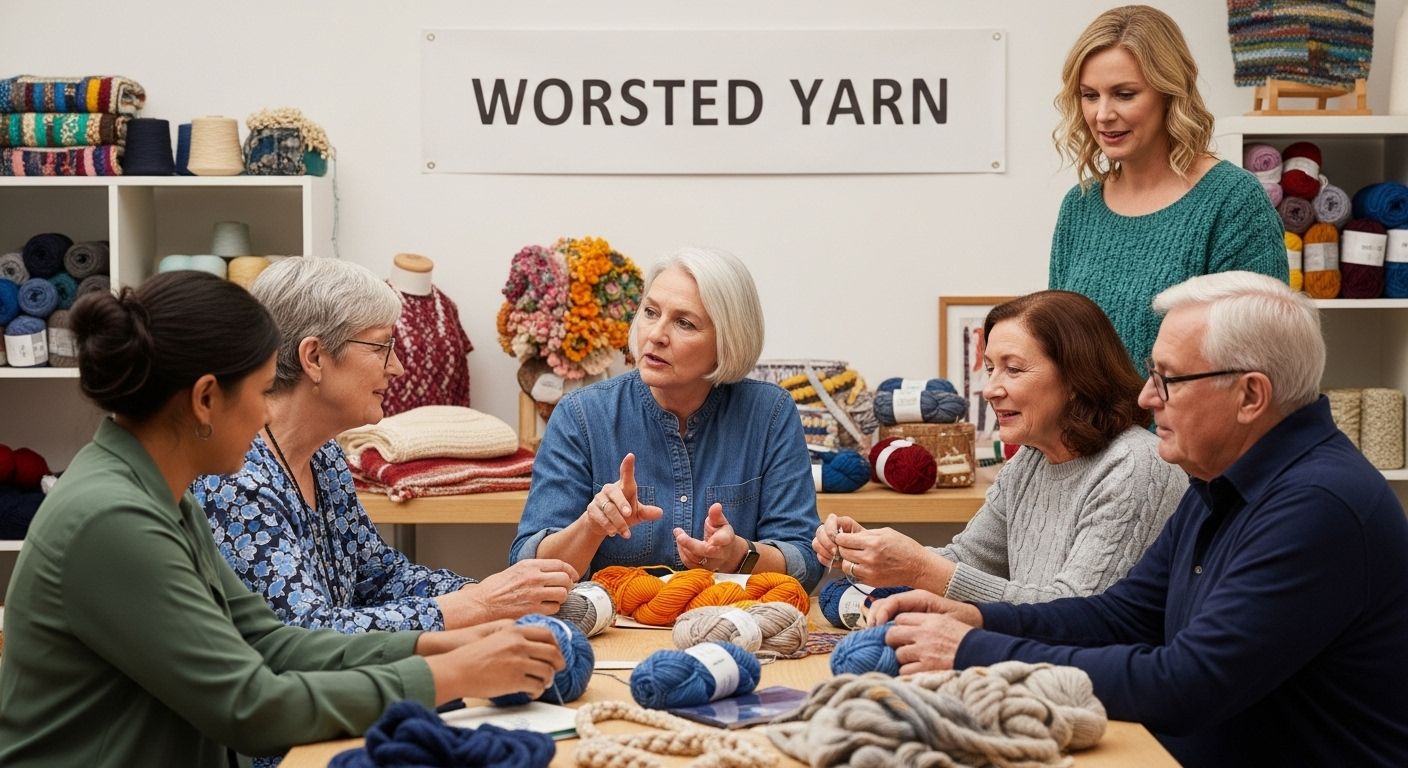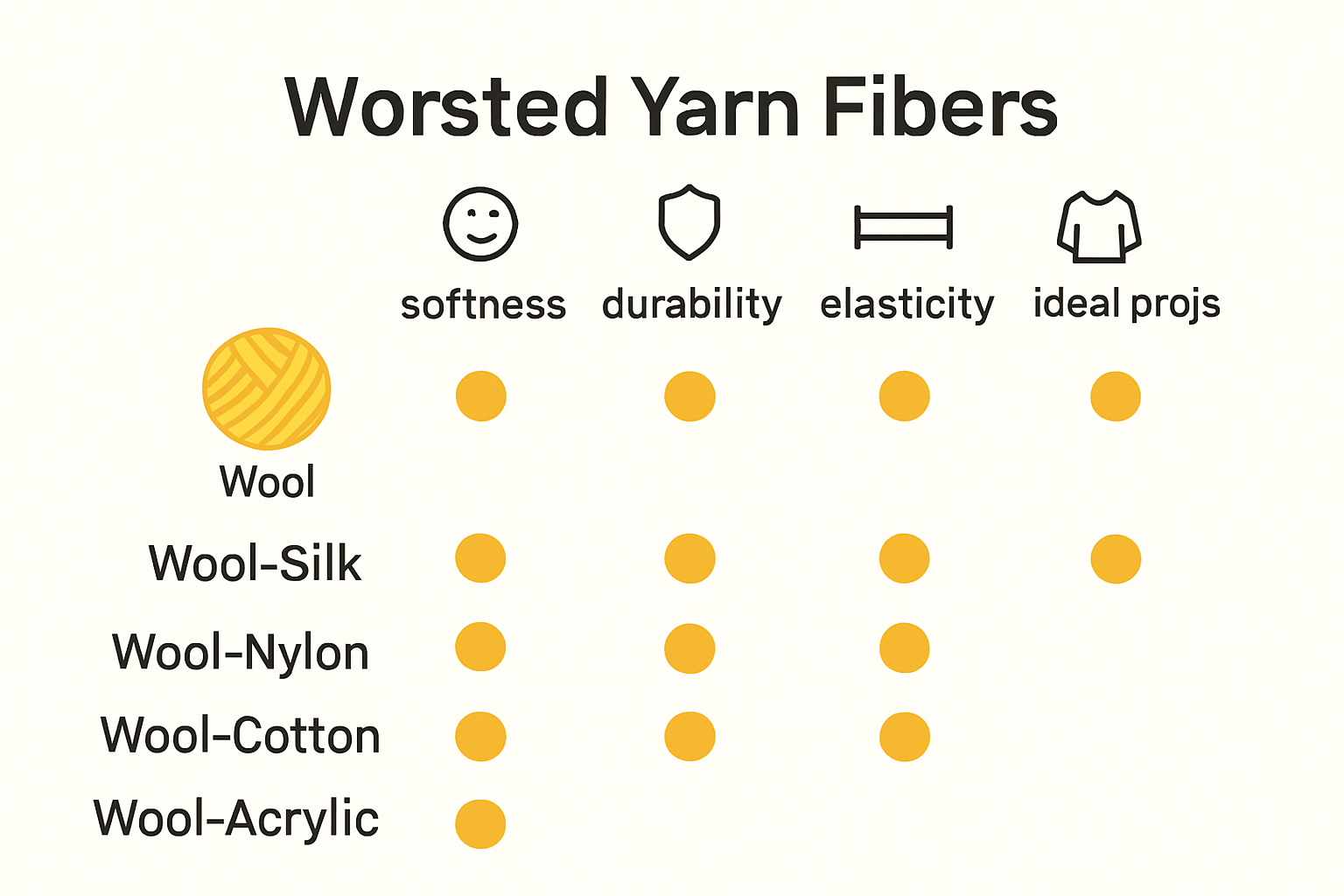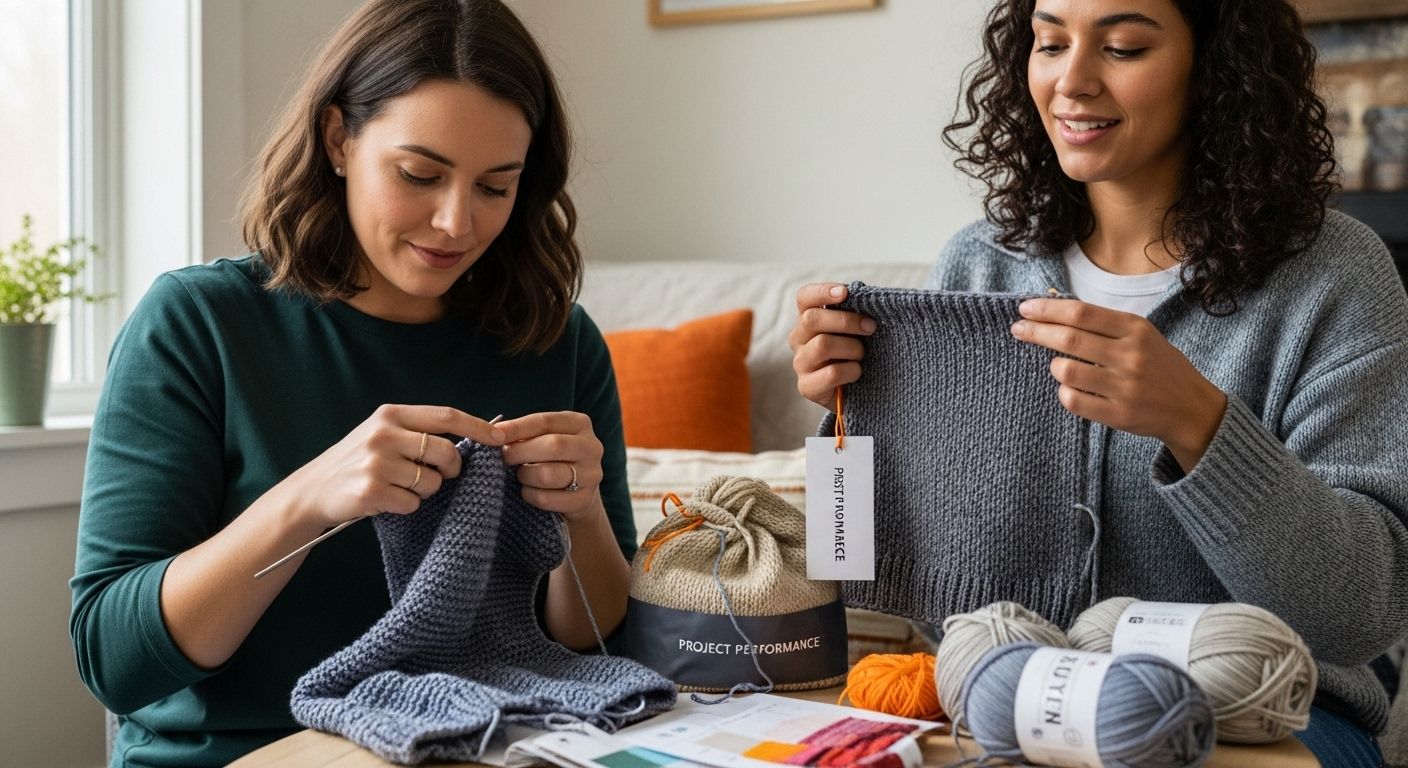
What is Worsted Yarn? Understanding Its Uses and Qualities
Worsted yarn might sound like just another crafting material, but the way it’s made changes everything about how it feels and performs.

Most people have no idea that this yarn goes through a combing process where the fibers are lined up so precisely that every strand is smoothed and strengthened by removing the shorter hairs. That means worsted yarn is not just smoother than ordinary wool yarn, it’s actually engineered for projects that demand crisp definition and long-lasting results.
Table of Contents
- Defining Worsted Yarn: Composition And Characteristics
- The Importance Of Yarn Weight: Why Worsted Matters
- How Worsted Yarn Is Made: From Fiber To Finished Product
- Exploring Different Types Of Worsted Yarn: Varieties And Uses
- Choosing The Right Worsted Yarn For Your Projects: Key Considerations
Quick Summary
| Takeaway | Explanation |
|---|---|
| Worsted yarn has a unique production process | This yarn is made from longer wool fibers, ensuring a refined texture and appearance. |
| Fiber alignment yields higher quality yarn | The meticulous combing and carding process create smoother, more uniform yarn suitable for fine garments. |
| Worsted weight is versatile and reliable | This medium-weight option works well for various projects, offering consistent results across different textile applications. |
| Material composition impacts project outcomes | Selecting the right fiber blend is crucial for performance, durability, and aesthetics in crafting projects. |
| Understanding yarn weight improves selection | Knowledge of yarn weight helps crafters choose the right thickness for their specific project needs, enhancing overall quality. |
Defining Worsted Yarn: Composition and Characteristics
Worsted yarn represents a sophisticated textile manufacturing process that transforms wool into a uniquely structured and refined textile material. Unlike other yarn types, worsted yarn undergoes a specialized production method that creates a distinct texture and performance profile.
Fiber Selection and Processing
The journey of worsted yarn begins with carefully selected wool fibers, typically ranging from 2 to 8 inches in length. These longer wool fibers are critical to creating the yarn’s signature smooth and structured appearance. According to Colorado State University Extension, the wool undergoes a meticulous preparation process that sets worsted yarn apart from other textile production methods.
The preparation involves several key steps:
- Initial scouring and cleaning of raw wool
- Careful carding to organize fiber alignment
- Precise combing to create parallel fiber arrangement
- Drawing and spinning to create the final yarn structure
Unique Characteristics of Worsted Yarn
Worsted yarn distinguishes itself through several notable characteristics. The parallel fiber alignment creates a yarn that is smoother, more compact, and significantly different from traditional woolen yarns. This unique structure results in a textile that is:
- Harder and more structured
- Smoother to the touch
- More uniform in appearance
- Better suited for fine, crisp garments and textiles
The research from textile engineering experts highlights that worsted yarn’s manufacturing process yields a material that transcends traditional wool expectations. Its refined production method ensures a higher quality yarn with exceptional performance characteristics, making it a preferred choice for high-end clothing, upholstery, and precision textile applications.
For crafters and textile enthusiasts interested in understanding more about yarn selection, our comprehensive guide on yarn weights provides additional insights into choosing the right yarn for your projects.
The Importance of Yarn Weight: Why Worsted Matters
Yarn weight represents a fundamental characteristic that dramatically influences the outcome of textile and crafting projects. Within this spectrum, worsted weight yarn occupies a pivotal position, offering crafters versatility and consistent performance across multiple applications.
Understanding Yarn Weight Fundamentals
Yarn weight refers to the thickness of the yarn strand, which directly impacts project gauge, needle or hook size, and final textile characteristics. According to Craft Yarn Council standards, yarn weights range from lace-thin to super bulky, with worsted weight positioned as a medium-weight option that balances performance and flexibility.
Key considerations for yarn weight include:
- Thickness of the yarn strand
- Recommended needle or hook sizes
- Anticipated fabric density and drape
- Project-specific requirements
Worsted Weight: The Versatile Middle Ground
Worsted weight yarn emerges as an exceptional choice for crafters seeking predictable and adaptable textile solutions. Its medium weight makes it ideal for a wide range of projects, from intricate garments to practical home accessories. The standardized thickness ensures consistent stitch definition and uniform fabric structure.
Projects particularly well-suited for worsted weight yarn include:
- Sweaters and cardigans
- Blankets and throws
- Hats, scarves, and mittens
- Amigurumi and stuffed toys
For crafters looking to expand their understanding of yarn selection, our comprehensive guide to yarn weights provides deeper insights into making informed textile choices. The balanced nature of worsted weight yarn makes it an excellent starting point for both novice and experienced crafters seeking reliable, high-quality results.
How Worsted Yarn Is Made: From Fiber to Finished Product
The production of worsted yarn represents a complex and precision-driven textile manufacturing process that transforms raw wool fibers into a refined, high-performance textile material. This intricate journey involves multiple carefully orchestrated stages that demand technical expertise and meticulous attention to detail.
Initial Fiber Preparation
The worsted yarn manufacturing process begins with strategic fiber selection. Wool fibers must meet specific length and quality criteria, typically ranging between 2 to 8 inches. According to textile manufacturing research, these longer fibers are crucial for creating a smooth, uniform yarn with exceptional structural integrity.
Key initial preparation steps include:
- Sorting and grading raw wool fibers
- Removing impurities and debris
- Washing and scouring to clean the wool
- Drying fibers to prepare for further processing
Advanced Processing Techniques
Once prepared, the wool undergoes a series of sophisticated transformation techniques. Combing emerges as the most critical stage, where fibers are meticulously aligned and parallel arranged. This process eliminates shorter, less uniform fibers and creates a streamlined fiber configuration that defines worsted yarn’s distinctive characteristics.
The advanced processing involves:
- Precise mechanical combing
- Drawing and drafting to further align fibers
- Controlled spinning to create yarn strands
- Twist insertion to provide structural strength
Final Refinement and Quality Control
The concluding stages of worsted yarn production focus on achieving optimal performance and aesthetic qualities. Finishing processes like washing, steaming, and tension setting ensure the yarn meets rigorous industry standards. For crafters interested in understanding more about yarn creation, our detailed guide on yarn fundamentals offers deeper insights into this fascinating textile transformation process.
Through these intricate manufacturing stages, raw wool is metamorphosed into a versatile, high-quality yarn that serves as the foundation for countless textile and crafting applications.
The following table summarizes the main stages in the worsted yarn production process, providing a clear view of each step and its purpose.
| Stage | Description |
|---|---|
| Fiber Selection and Sorting | Choosing quality long wool fibers (2-8 inches) |
| Scouring and Cleaning | Removing impurities and debris |
| Carding | Organizing fibers in a preliminary alignment |
| Combing | Making fibers parallel, removing shorter/irregular fibers |
| Drawing and Spinning | Creating continuous, strong yarn strands |
| Twist Insertion | Adding strength and consistency to the yarn |
| Final Finishing (Washing, Steaming) | Ensuring smoothness, appearance, and structural integrity |
Exploring Different Types of Worsted Yarn: Varieties and Uses
Worsted yarn is not a monolithic material but a diverse textile category with multiple variations tailored to specific crafting needs and performance requirements. Understanding these nuanced varieties enables crafters to select the most appropriate yarn for their unique projects.
Wool Breed Variations
The foundation of worsted yarn diversity lies in the wool breeds used during production. According to American Wool Council research, certain wool breeds contribute distinctive characteristics to the final yarn. Merino and Rambouillet wools, for instance, are prized for their exceptionally fine fibers and soft texture.
Key wool breed characteristics include:
- Fiber length and diameter
- Softness and elasticity
- Natural color variations
- Thermal regulation properties
Fiber Composition and Blends
Modern worsted yarns extend beyond pure wool, incorporating innovative blends that enhance performance and aesthetic qualities. Synthetic and natural fiber combinations provide crafters with versatile materials suited to diverse applications.
Common worsted yarn blend types encompass:
- Wool and nylon for increased durability
- Wool and silk for luxurious sheen
- Wool and cotton for breathability
- Wool and acrylic for affordability
Specialized Worsted Yarn Applications
Each worsted yarn variety offers unique advantages for specific crafting domains. Finer worsted yarns excel in delicate garment construction, while more robust variants suit heavy-duty textile projects. Our comprehensive guide to yarn selection provides deeper insights into matching yarn types with project requirements.
From lightweight sweaters to sturdy outdoor wear, worsted yarn’s remarkable versatility ensures crafters can find the perfect material for virtually any textile endeavor.

Choosing the Right Worsted Yarn for Your Projects: Key Considerations
Selecting the ideal worsted yarn requires a nuanced understanding of project requirements, material properties, and personal crafting preferences. Crafters must navigate multiple factors to ensure their chosen yarn delivers optimal performance and aesthetic appeal.
Project-Specific Performance Factors
Each crafting project demands unique yarn characteristics that directly impact the final textile’s quality and functionality. According to textile research in Materials, considerations extend far beyond simple visual appeal.
Critical performance considerations include:
- Intended project durability
- Expected frequency of use
- Washing and maintenance requirements
- Climate and wear conditions
Material Composition Evaluation
Yarn composition significantly influences project outcomes. Different fiber blends offer distinct advantages, making material selection a strategic decision. Synthetic and natural fiber combinations provide crafters with tailored solutions for specific performance needs.
Key material blend considerations:
- Wool percentage and quality
- Synthetic fiber integration
- Elasticity and shape retention
- Cost and sustainability factors
Aesthetic and Functional Matching
Successful yarn selection balances visual preferences with functional requirements. Crafters must assess how yarn characteristics align with their creative vision and practical needs. Our comprehensive yarn selection guide offers deeper insights into making informed choices.
Ultimately, choosing the right worsted yarn transforms from a technical decision to an art form, where material science meets creative expression.

Discover the Perfect Worsted Yarn for Every Project
Struggling to choose the right worsted yarn after learning about fiber qualities and project demands? You are not alone. Many crafters face the challenge of finding yarn that matches both their technical needs and their creative vision. With so many types, blends, and weights out there, making the right choice can feel overwhelming. Our curated Yarn collection removes the guesswork, offering premium worsted options crafted for clarity, consistency, and comfort.
.png)
Take the next step and visit CRAFTISS to explore our hand-picked worsted yarns. Ready to keep your supplies organized? Complete your experience with our spacious Yarn Bags. Elevate your craft today with tools designed to make every stitch rewarding. The best results start with the right materials—shop now while top selections are still in stock.
Frequently Asked Questions
What is worsted yarn?
Worsted yarn is a refined textile material made from longer wool fibers that undergo a unique manufacturing process. This process includes scouring, carding, combing, and spinning, resulting in a smooth, structured yarn suitable for various high-quality garments and textiles.
What are the characteristics of worsted yarn?
Worsted yarn is known for its smooth texture, structural integrity, and uniform appearance. It is harder, more compact, and better suited for creating fine and crisp garments compared to traditional woolen yarns.
How is worsted yarn different from other types of yarn?
Worsted yarn differs from other yarn types primarily in its fiber alignment and production process. It consists of longer, parallel fibers, making it smoother and stronger, unlike woolen yarn, which is typically fluffier and made from shorter fibers.
To help clarify the differences between worsted yarn and traditional woolen yarns, the following comparison table outlines their key characteristics.
| Feature | Worsted Yarn | Woolen Yarn |
|---|---|---|
| Fiber Alignment | Parallel, smooth | Random, crimped |
| Fiber Length | Longer fibers (2-8 inches) | Shorter fibers |
| Texture | Smooth, compact | Fluffy, airy |
| Appearance | Uniform, crisp | Soft, fuzzy |
| Common Uses | Fine garments, upholstery, precision textiles | Warm, lofty knits (sweaters, hats) |
| Durability | Higher, holds structure | Lower, more prone to pilling |
| Stitch Definition | Excellent, sharp stitch definition | Softer, less defined |
What projects are best suited for worsted yarn?
Worsted yarn is versatile and ideal for various crafting projects, including sweaters, cardigans, blankets, hats, scarves, mittens, and even amigurumi. Its consistent thickness ensures uniform stitch definition, making it a favorite among both novice and experienced crafters.
Recommended
-
[ What is worsted weight yarn?
– CRAFTISS](https://craftiss.com/blogs/news/what-is-worsted-weight-yarn)
-
[ Understanding the Role of Yarn Weight in Crafting
– CRAFTISS](https://craftiss.com/blogs/news/understanding-the-role-of-yarn-weight)
-
[ Why Use Lightweight Yarn: Understanding Its Benefits
– CRAFTISS -
[ What is fingering weight yarn? A complete guide to this versatile yarn
– CRAFTISS


